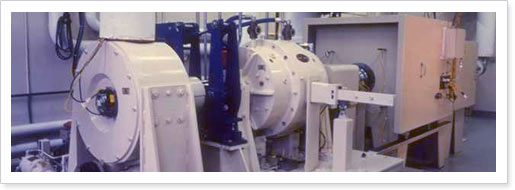Jet Engine Starter Test Facility
Hamilton Sundstrand | 1994 Engineering Excellence State Award
The Problem:
Manufacturers must test aircraft components rigorously to obtain government flight approval. For jet engine starters, tests for performance, emergency re-engagement, severe temperature, burst margin and 5,000 cycle endurance are required.
In the typical starter test stand, a flywheel simulates the inertia of the jet engine. The starter must accelerate the flywheel to operating speed within an allowable time.
The flywheel test rig has several drawbacks:
- Many flywheels are required to simulate different engines. Downtime and labor costs for flywheel replacement can be significant.
- Dynamic forces such as windage, friction and engine acceleration are ignored.
- Large flywheels are required to simulate modern engines. These flywheels can pose safety problems due to their large energy storage capacities (10.5x10^6 ft-lb). The heavy spinning mass is difficult to stop.
- Very strong shielding is needed to contain possible failures.
The Solution:
Hamilton Standard engineers constructed a computer model to simulate the starting loads for each starter in their inventory. These models simulate inertia, windage, friction, engine ignition, and engine drive line spring rate. Emprise uses this data to create starter time-speed-torque curves that represent actual starter duty cycles where torque is highest at low speeds and gradually goes negative as the engine begins to produce power. While the required rotor torque is positive the starter is under load, but as engine operation begins the engine rotor accelerates and the starter disengages by an overrunning clutch.
Thus, engine rotor dynamic simulation requires a load and drive servo system. Furthermore, the maximum torque load occurs at very low speeds and the drive requirement occurs at very high speeds. Few servo systems contain both characteristics.
Emprise incorporates a wet gap, drum-type eddy current dynamometer for the load servo. This older design provides an ideal combination of good low speed torque and 10,000 RPM to speed operation. This servo, coupled with a computer control system, provides the load simulation up to the point of clutch disengagement. A pneumatic turbine couples directly to the dynamometer rotor and provides the drive system.

The Results:
The Emprise starter test rig combines various existing technologies in a unique way. The approach is both creative and cost effective. The cost of a test facility is usually directly proportional to the accuracy of the test simulation. For the Emprise starter test rig, however, accuracy is greatly improved while construction costs remain in line with costs for a conventional rig. Additionally, operating costs are significantly decreased by eliminating manual tasks such as flywheel service.
The eddy current dynamometer and air turbine represent an innovative method for testing engine starters. Improving a design while decreasing costs is a measure of true engineering achievement.